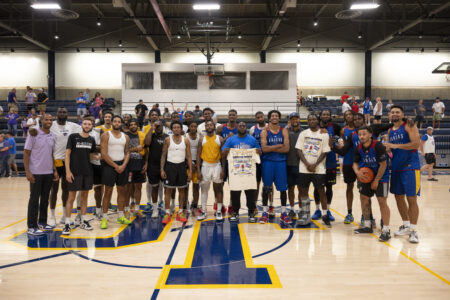Stats say Taylor deserves Cousy mention
The Wooden Award. The Naismith Trophy. The Associated Press College Basketball Player of the Year award. The Oscar Robertson Trophy. The Adolph Rupp Trophy.
The Heisman Trophy.
The Heisman is more than 10 times as powerful as any college basketball honor because it stands alone.
College basketball has too many awards, including the Bob Cousy Award, given to the nation’s top point guard.
Too many honors or not, if somebody’s going to select an award-winner, the most deserving finalists need to be identified.
The Cousy Award selection committee almost did that. Almost. Conspicuous by his absence from the field of 11 finalists is Kansas University senior guard Tyshawn Taylor.
Winning percentage is the most important statistic for a point guard, and in that regard the floor-general finalists all grade high. Isaiah Canaan (Murray State), Aaron Craft (Ohio State), Matthew Dellavedova (Saint Mary’s), Scoop Jardine (Syracuse) Damian Lillard (Weber State), Scott Machado (Iona), Kendall Marshall (North Carolina), Phil Pressey (Missouri) and Casper Ware (Long Beach State) all play for teams that either lead their conference standings outright or have a share of first place.
Jordan Taylor’s Wisconsin Badgers are in fourth in the Big Ten, one game out of the lead. Jackson’s Baylor Bears are tied for third in the Big 12.
Had Tyshawn Taylor been a 12th finalist, he would have ranked third in the field with a .451 three-point percentage, tied for third with a .489 field-goal percentage and fourth with 17 points per game. He lags behind most of the field in just one important point guard indicator, an important one. Taylor’s 1.39 assists-to-turnovers ranks ahead of only Ware’s 1.24.
Far more powerful statistical comparisons than those state Taylor’s case more convincingly. He has played five games against Cousy finalists, winning four of them. Taylor’s statistics blow away the combined numbers of the Cousy finalists in head-to-head games against Ware, Craft, Jackson (twice) and Pressey.
In the only KU loss, Taylor played a terrific 36 minutes, a horrific 37th and 38th minutes. He outscored Pressey, 21-2, dominating him at both ends.
Taylor played two of the five games — Long Beach State and Ohio State — with a torn meniscus and was wearing a brace before having surgery.
In the five games, Taylor averaged 17.8 points, 5.8 assists and 5.2 turnovers and shot .533 overall and .550 from three-point range. The finalists combined to average 11.2 points, 4.6 assists and 2.2 turnovers and shot .360 overall and .389 on three-pointers.
Taylor averaged 6.6 points more than his man, and he had 1.2 assists more, which translates to 2.4 points. Put them together, and he’s nine points better. He also committed three more turnovers per game, and since the national average for points per possession is about one, subtract three points. Nine minus three is six. Head-to-head, he was six points better per game than the four finalists he faced. If all five starters were six points better than their man, that’s a 30-point margin of victory.
Taylor, averaging 20.4 points per game in the past nine games, is a great deal closer to being the best point guard in the country than the 12th-best.







